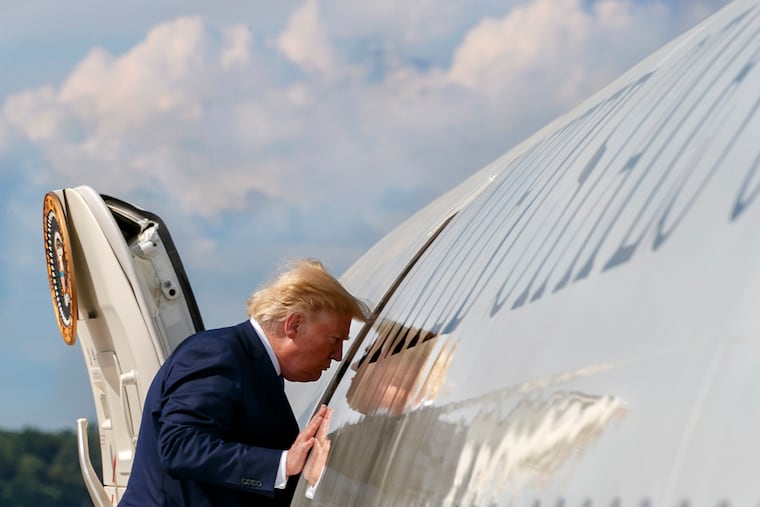Trump decries poverty in big cities, overlooking rural and suburban poor
Suburban poverty has long been on the rise. Today, by some researchers' count, there are roughly 3 million more Americans living in poverty in suburbs than in cities.

President Donald Trump recently blasted Democratic Congressman Elijah Cummings Jr.'s Baltimore district as a “disgusting, rat and rodent infested mess” where “no human being would want to live.”
He also extended attacks to Los Angeles, San Francisco, and Chicago, citing homelessness and other challenges.
The grievances Trump enumerated were mainly connected to poverty, which he linked only to urban America.
But the truth is, suburban poverty has long been on the rise. Today, by some researchers’ count, there are roughly three million more Americans living in poverty in suburbs than in cities.
And beyond the suburbs, large swaths of white, rural America suffer from a stubborn indigence that can limit opportunity and stifle hope.
Of the 15 poorest states, 11 are in the South, including those with large, low-income rural sections such as Mississippi, Louisiana, Alabama, Kentucky, Georgia, Tennessee, North Carolina, and South Carolina, federal statistics show. Pennsylvania is listed as 32nd-poorest, while New Jersey, one of America’s three wealthiest states, is 48th.
Fourteen of the 15 poorest states, by the way, voted for Trump. And in a USA Today listing of the 35 poorest towns in the United States, with poverty rates as high as 40%, 27 are in states that voted for Trump. The overwhelming majority are in Southern states.
Further, states such as Mississippi, West Virginia, Tennessee, and Louisiana are among the top recipients of food stamps in the entire country, data from the U.S. Department of Agriculture show.
“Overall,” said economist James Ziliak, director of the Center for Poverty Research at the University of Kentucky, despite complaints about cities grabbing government largesse, “most of the Southern states receive more money from federal coffers than they give in taxes.”
And while the economic recovery since the Great Recession is fostering improvements in urban America, it’s not as pronounced in the countryside, he added.
“Things are worrisome in rural areas,” Ziliak said. “Jobs aren’t being created there at the same rates as in urban centers, and whatever jobs there are tend to be low-wage.”
While much of urban America is benefiting from low unemployment, the advantages aren’t shared in the countryside, he added. So many rural people have been out of work for so long, they’ve ceased looking for jobs, and are no longer counted as being unemployed, Ziliak said.
Ziliak said that among men with no high school education or job skills throughout America, 70% are employed in urban areas, while just 55% are employed in rural sectors.
And problems among those living in poverty in the suburbs may be even worse.
Suburban poverty isn’t often regarded as much of a problem in the popular imagination, according to reporting in City Lab. It’s “inner cities” — code for poor, black, urban communities — that receive the brunt of the attention, City Lab wrote, while “rising poverty in the American suburbs has been allowed to fester and grow."
Between 2000 and 2015, the number of Americans in poverty grew by 11.5 million, with suburbs accounting for 5.7 million or 48 percent of that increase, according to data from the Institute for Research on Poverty at the University of Wisconsin. Around 43 million people lived in poverty throughout America in 2015.
By denigrating Baltimore and other cities, Trump is minimizing the poverty, homelessness, and suffering in the suburbs and especially in rural America, where his base is, said sociologist Joan Maya Mazelis, an expert on poverty and its stigma at Rutgers University-Camden.
“He doesn’t want to come across as blaming those who voted for him,” Mazelis said.
She added that Trump and many others promote the idea of rural America as “real America.”
That concept, Mazelis said, “is equated with smaller towns, fewer people of color, where it’s easier to ‘other’ people who are not white."
What’s worth noting, she added, is that stigmatizing those in poverty occurs in low-income rural areas, as well.
“If you’re in a poor state or town, you talk about other people, saying they’re cheating and lying when they get food stamps,” Mazelis said. “But even if you’re in that same town getting food stamps yourself, you’ll think of yourself as good and honorable, and only temporarily getting government help.”
In her research on stigma among low-income Americans, Mazelis found that people will, above all else, keep a thick line drawn between themselves and others in need.
She added, "I interview people who say, ‘I’m not poor, because I have shoes, and poor means not having shoes.' Or, they’ll say, ‘I’m not poor, because poor means eating out of the trash, and I don’t do that.’
“It’s why so many Americans call themselves middle class, even when they’re not. They’ll always find ways to say, ‘The poor are not me.’ ”